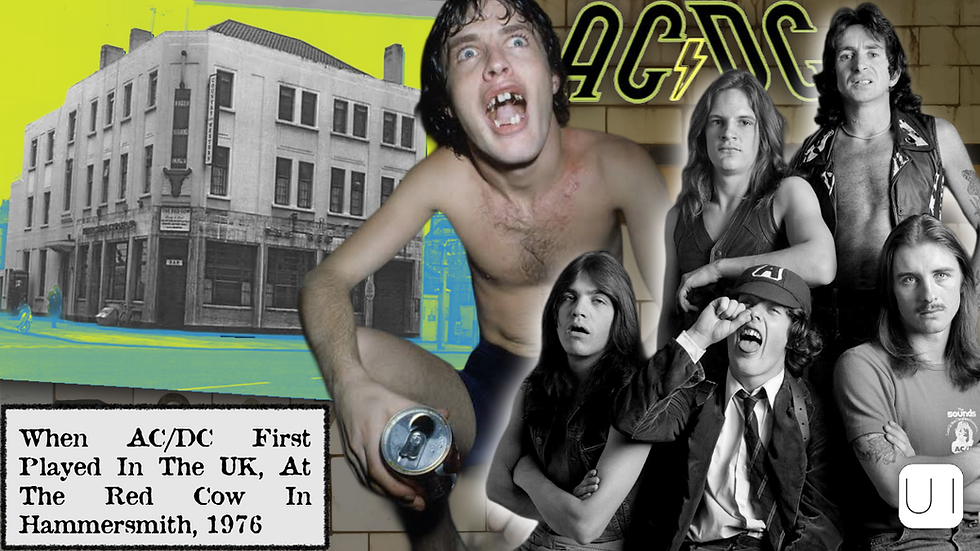AC/DC’s And Their First Gig In London At The Red Cow in Hammersmith, 1976
- Daniel Holland

- Sep 1
- 6 min read

On 23 April 1976, a little West London pub called The Red Cow played host to an event that, at the time, looked like nothing more than another sweaty Friday night. AC/DC, an unknown Australian rock band with an unshakable faith in volume knobs, played their very first gig in Britain. Fewer than 30 people showed up at first. By the end, everyone was squeezed into a back room that had all the ambience of a damp cupboard with dodgy electrics. Nobody knew they were watching the birth of a global rock juggernaut, they just knew it was very, very loud.
A Pub With Character (and Terrible Toilets)
The Red Cow was the sort of pub that would never have made it into a glossy guidebook. It was a typical West London boozer: pints slightly flat, carpets with a permanent sticky sheen, and toilets that doubled as an alternative entrance when people wanted to avoid paying. The official capacity of the backroom was 250, though in reality the number was determined by how many bodies could sweat into the same air without fainting.

Still, the Red Cow had a reputation. It was one of the linchpins of London’s pub rock scene, that short-lived but vital moment in the mid-70s when bands ditched the pomp of prog and the glitter of glam in favour of cheap beer and battered amps. You could see Bees Make Honey or Ian Dury & The Blockheads for 50p – or, if you were skint, wait for a free gig and pray the band was decent.
Into this scene stepped AC/DC, an act with two albums (High Voltage and T.N.T.) that weren’t even officially released in Britain. At home in Australia, they were already stars. In the UK, they were nobodies.
From Sydney to Hammersmith
The Young brothers, Malcolm and Angus, had grown up in a working-class Scottish family that emigrated to Sydney in the 1960s. In a family where practically everyone owned a guitar, starting a band was less a lifestyle choice and more a household chore. Angus, the youngest, hit upon the bright idea of dressing in a schoolboy uniform on stage, not because of some grand concept, but because his sister Margaret suggested it, and nobody in the family had the heart to tell him it looked ridiculous.
Ridiculous or not, it worked. Angus became the whirling, duck-walking visual centrepiece of the band. Add in Bon Scott, the hard-living, harder-drinking frontman whose charisma was matched only by his ability to sweet-talk bartenders, and you had a volatile formula. In Australia, they conquered radio and dominated beer-soaked venues. In Britain, they were just five blokes with amplifiers looking for a fight.
Atlantic Records decided to start small. They rented the band a shared house in Richmond, South London, (just 12 miles from where Bon would die only 4 years later) it was a dump, but it had a roof and functioning plumbing, which put it a step above the Red Cow.
The First Set: 30 People and a Lot of Feedback
When AC/DC ambled on stage at the Red Cow, the audience looked like a random sample of 1976 Britain: a couple of punks, some students with questionable haircuts, and the odd long-haired rock loyalist. Barely 30 people stood around waiting to see what the fuss was about.
Then Angus hit the opening chords of “Live Wire.” Suddenly, the atmosphere changed. Here was a band that didn’t look like much, unless you considered Angus’ uniform, which made him resemble a child who’d run away from prep school, but they played with a ferocity that turned heads instantly.
The first set lasted only seven songs. But it was enough to prove they weren’t just another pub rock band trying to copy the Rolling Stones and failing. These Australians had energy, riffs, and the sort of commitment to noise that could peel paint off the walls.
Bon Scott at the Bar
Between sets, Bon Scott did what Bon Scott always did: went to the bar. Accounts say he chatted with punters, blagged free drinks off a confused barman, and charmed his way into disappearing later with two girls. It was a masterclass in rock ’n’ roll diplomacy – no spreadsheets, no PR strategy, just a grin and a leather jacket.
The Second Set: Word Gets Out
By the time the second set began, word had spread. The once half-empty room was now jammed. People were squeezing in through windows and sneaking through the aforementioned grotty toilets just to get a glimpse.
The band’s energy level, already high, went through the roof. They tore through a setlist that reads today like a miniature greatest hits package:
Live Wire
She's Got Balls
It’s a Long Way to the Top (If You Wanna Rock 'n' Roll)
Soul Stripper
Can I Sit Next to You Girl
The Jack
High Voltage
T.N.T.
Baby, Please Don’t Go
The closing number, “Baby, Please Don’t Go,” was pure chaos – exactly the sort of sweaty, pounding closer that left people with ringing ears and sore throats the next morning.
Lock Up Your Daughters
If the Red Cow gig was the spark, the fire came with AC/DC’s “Lock Up Your Daughters” tour, launched later that month. The name was knowingly daft, the shows chaotic. Each night included an Angus Young lookalike competition, which was as much an excuse for drunken antics as it was a tribute.

The band spent most of 1976 living on the road, working their way from pubs to larger venues like the Lyceum Ballroom in London. They played anywhere that would have them, often two sets a night, driving themselves and their crew to exhaustion.
Rock Meets Punk
The timing was remarkable. Britain in 1976 was on the edge of punk. The Sex Pistols were making headlines, The Clash were emerging, and the old guard of rock looked increasingly bloated. AC/DC somehow managed to appeal to both sides.
They weren’t punks, their songs were too rooted in Chuck Berry riffs and blues swagger. But they had the raw energy, the aggression, and the sheer volume that punks could appreciate. At the same time, they had enough classic rock chops to keep the denim-clad faithful happy.
It was a rare balancing act: a band that could play to a punk in safety pins and a rocker in flares without starting a fight.
From Oxford to Australia
By November, AC/DC had graduated from the Red Cow and its ilk. Their final UK gig of the year took place in Oxford on 15 November 1976. From there, they flew back to Australia for a triumphant homecoming.
The naysayers who predicted they’d fail outside their homeland were proved wrong. They’d not only survived, they’d thrived, finding a toehold in Britain that would soon turn into a stranglehold.
Why It Matters
In hindsight, the Red Cow gig feels mythical. A band that would go on to fill stadiums and sell millions of records once played to fewer than 30 people in a pub with dodgy plumbing. It’s a reminder that even the biggest legends start in small rooms with bad lighting and questionable hygiene.
The Red Cow is gone now, converted into a hotel, because London never misses a chance to gentrify its history. But for those who care about the story of rock, it remains hallowed ground. On that night in April 1976, with Angus duck-walking across a stage barely big enough to hold him, AC/DC proved that greatness doesn’t need glamour. It just needs noise, sweat, and a refusal to turn the volume down.
Sources
Murray Engleheart & Arnaud Durieux, AC/DC: Maximum Rock & Roll (Harper Collins, 2006) – comprehensive band biography covering their early years, including the 1976 UK debut.
Clinton Walker, Highway to Hell: The Life and Death of AC/DC Legend Bon Scott (Verse Chorus Press, 1994) – background on Bon Scott’s arrival in the band and their early tours.
Mick Wall, AC/DC: Hell Ain’t a Bad Place to Be (Orion, 2012) – detailed history of the band’s rise, with anecdotes from the Red Cow gig and Lock Up Your Daughters tour.
Classic Rock Magazine, “The Red Cow: The Pub That Launched AC/DC in the UK” (archival feature, 2016).
NME archives, gig listings for April 1976 – includes Red Cow dates with Bees Make Honey and Ian Dury.
BBC Music, “AC/DC: The Early Years” (feature, 2010).
London Pub Rock History Project, University of Westminster archives – context on venues like the Red Cow in the 1970s.
Setlist.fm, “AC/DC Setlist at The Red Cow, London, April 23, 1976” – reconstructed setlist from fan records.











































































































Great article. One correction: While the Red Cow as it was then is gone, there is still a pub on the site, built in the early 1980s. No live music as far as I know, but a pub.
A real rock and roll moment, great write up